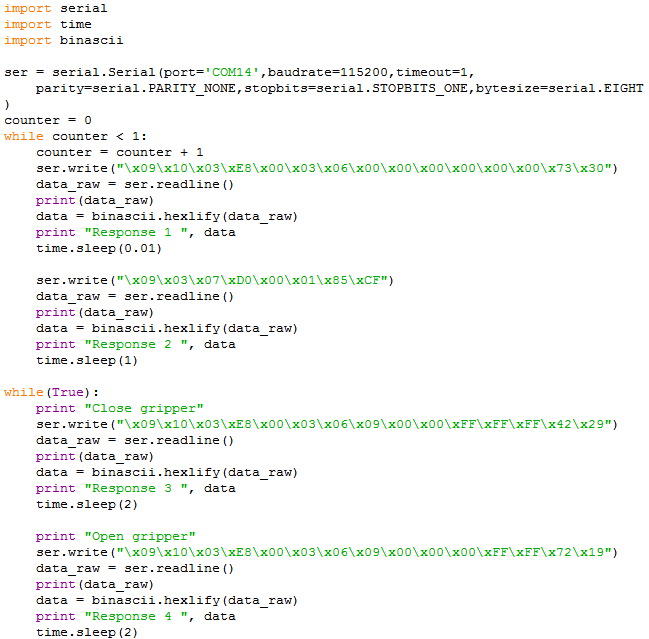Python Pyserial Readline Example
I am reading serial data like this: connected = False port = 'COM4' baud = 9600 ser = serial.Serial(port, baud, timeout=0) while not connected: #serin = ser.read() connected = True while True: print('test') reading = ser.readline().decode() The problem is that it prevents anything else from executing including bottle py web framework. Adding sleep() won't help. Changing 'while True' to 'while ser.readline():' doesn't print 'test', which is strange since it worked in Python 2.7. Any ideas what could be wrong? Ideally I should be able to read serial data only when it's available. Data is being sent every 1,000 ms. Using a separate thread is totally unnecessary.

Just do this for your infinite while loop instead (Tested in Python 3.2.3): while (True): if (ser.inWaiting()>0): #if incoming bytes are waiting to be read from the serial input buffer data_str = ser.read(ser.inWaiting()).decode('ascii') #read the bytes and convert from binary array to ASCII print(data_str, end=') #print the incoming string without putting a new-line (' n') automatically after every print() #Put the rest of your code you want here This way you only read and print if something is there. You said, 'Ideally I should be able to read serial data only when it's available.'
Can someone please show me a full python sample code that uses pyserial. Full examples of using pySerial package. Response = ser.readline(). Be careful when using readline(). Do also have a look at the example files in the examples. Is no longer supported when pySerial is run with newer Python.
This is exactly what the code above does. Moffatt Bible Download Free. If nothing is available to read, it skips on to the rest of your code in the while loop.
Totally non-blocking. (This answer originally posted & debugged here: ) pySerial documentation.
Closed as off-topic by,,,, Oct 24 '16 at 17:51 This question appears to be off-topic. The users who voted to close gave this specific reason: • 'Questions asking us to recommend or find a book, tool, software library, tutorial or other off-site resource are off-topic for Stack Overflow as they tend to attract opinionated answers and spam. Instead, and what has been done so far to solve it.' – Drew, miken32, Machavity, doelleri, SZenC If this question can be reworded to fit the rules in the, please. Blog post import time import serial # configure the serial connections (the parameters differs on the device you are connecting to) ser = serial.Serial( port='/dev/ttyUSB1', baudrate=9600, parity=serial.PARITY_ODD, stopbits=serial.STOPBITS_TWO, bytesize=serial.SEVENBITS ) ser.isOpen() print 'Enter your commands below. R nInsert 'exit' to leave the application.' Input=1 while 1: # get keyboard input input = raw_input('>>') # Python 3 users # input = input('>>') if input == 'exit': ser.close() exit() else: # send the character to the device # (note that I happend a r n carriage return and line feed to the characters - this is requested by my device) ser.write(input + ' r n') out = ' # let's wait one second before reading output (let's give device time to answer) time.sleep(1) while ser.inWaiting() >0: out += ser.read(1) if out!= ': print '>>' + out.